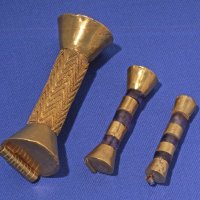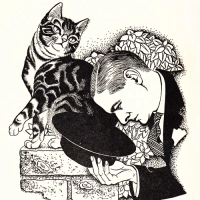Part I is here: Visitors on the Wild Side of Lake Tanganyika – I
Moving ‘up’ the wildlife chain… We have many guinea fowl in the wild – and a while back I was given a clutch to keep. They make excellent guardians, screeching away when strangers enter. Also they are good to eat, of course.

Guinea Fowl in the Rusizi Wetlands

White faced scope owl - favorite place was on files... Not so great for the files...
Lots of owls abound, although one does not see so much of them. They are considered highly unlucky in some parts of Africa. Here are some babies that I raised, above and below, who had been orphaned. They were successfully released into the wild:

baby Cosgrave on my gloved hand.
One day a few years ago, at the Cercle Hippique (Riding Club), a bat literally fell out of the sky in front of me and some friends. It must have been sick, because it died. Bats like to find places to live in your attic or roof eves. The first house where we were with the project had wonderful bat-roosting facilities – and in the evenings the little bats would swoop into the house and circle the inside in search of flying insects. It was a 3-story, open and 6-sided house, huge African-style, perfect for bats. Unfortunately, the 4 cats loved chasing them and found it relatively easy to catch them. The bats’ radar didn’t seem capable of sensing cats – only insects. I or someone else were always rescuing squeaking, angry bats from the cats.

Eating a roach. ALF
On a training exercise that I conducted upcountry, I bought a Serval Cat skin from a traditional healer at a local market for less than a dollar. This was by way of ‘repayment’ for learning about some of her traditional meds and healing practices. Back at home, I hung it on the wall, whereupon a worker exclaimed when seeing it: “Where’s the Meat!?” 😮
Serval Cats are really beautiful – not very big, and extremely elegant.

Serval in Tanzania grasslands

The white flash marks behind the ears are thought to give directions to new kits so that they can find and follow their mother in heavy brush lands.
In the ‘old days’, Serval Cat skins were worn, but only by notables – as shown in the following picture. I understand they are not in danger (the Serval cats, not the notables). They continue to be caught for their skins and medicinal powers and the flesh is eaten.
John Hanning Speke comments in one of his mid-nineteenth century writings on central-east africa, that a young man came to their camp who was wearing a Serval skin, but everyone knew he was a commoner and not a member of the royal family. He was de-cloaked and sent home in disgrace, as I remember

Prince Bishinga, Burundi c.1900
Leopards still exist over in the Congo and their young are sometimes raised by local folk. Here is one that is pretty tame. It’s waiting for a bigger cage to be built.

Pet leopard, who has gotten a bit big to understand what being a 'pet' means.
Hippopotami are in abundance in Lake Tanganyika – though the rebels and military both in Burundi and the Congo have been decimating their numbers over the last 15 years. Being relatively isolated, they can be huge, and one night driving back out to the lake I came upon a tremendously huge hippo on the road – he was sideways, and blocked the entire road together with the shoulders of the road. Hippos are extremely dangerous and kill more people than any other beast in Africa. I quickly went into reverse and sped backwards for a long ways.
In Kenya I knew, briefly, a very silly person who insisted camping out on the shores of Lake Naivasha – even though we warned him it was quite foolhardy. During the night he was attacked and killed by a hippo. It seemed he’d erected his little tent on a hippo trail. Hippos have their own trails, which are marked by the males. They are extremely territorial.
Before the fighting stopped a couple of years ago, shooting during the night could indicate either pot-shots at rebels by the military (or vice-versa), or the killing of a hippo. Once, we heard shooting just on the other side of the compound gate, and the next morning were presented with part of a hippo haunch (since it was shot right by our gate, we were told by the military that we were eligible for some of the meat). Their flesh is pretty good.

Hippos and migratory birds on an island in the Rusizi. Wiki
Before people started coming back out here to the lake (after the war), one could listen to the hippos fighting, or perhaps just talking during the night. They come out of the water during the night-time to graze, and did drive the village farmers crazy with the amount they would eat from the cultivated crops. I do miss them, though we still see them from time to time in the lake – and just last Friday there were a couple that I watched while eating breakfast.

Never get any closer than this to a hippo when in a boat. They have a tendency to submerge and come up under the boat...
Crocks are also numerous in the lake – we have a famous, legendary crock named ‘Gustaf’, who is said to be the largest crock in the world and has been seen by many people (not me, though). He is very wise (and old) and cruises up and down the lake between here and Tanzania. The National Geographic was out here a while back to do a special on him, and brought a large balloon to noiselessly float over the Lake. Search ‘Gustav’ and ‘Lake Tanganyika’ and ‘Crocodile’ on Google and you can learn about him.
Every now and then a crock will snag a swimmer, usually where lots of boys are swimming.

Baby crocodile that lives down the beach.
Wart Hogs are not numerous, but still exist nearby us, in the Rusizi wetlands – here is a photo I took a while back:

Warthogs down in the Rusizi Wetlands
Gazelles – Yes, there are some of these left, too, up here at the North end of the lake, mainly smaller breeds such as the Dikdik. From time to time locals will come with a baby gazelle wanting to sell it to me. They are usually the young of a mother who has been caught in a trap. But much as I’d like to, I refuse for several reasons. First, I don’t want to encourage locals to snare wildlife in order to sell the young. Second, it is very difficult to raise them, and if they do make it to adulthood, one cannot turn them loose. The have to go into a zoo and there aren’t appropriate facilities here in Burundi. So, grizzly as it sounds, it is better they be consumed along with their mother.

Dikdik are so small that it is easy to miss seeing them if they hold still. They mate for life, so I've been told.
Elephants did exist here, migrating between this area and the Congo. In the 19th and early 20th Centuries they were brought down by local folks for their ivory, which was sold to Swahili traders up from the Kenya coast. The last one I have heard about was seen on an island in the Rusizi about 40 years ago. It was a youngster, who probably got left behind the herd as it was making its escape to the Cong hills (which is just a few klms. to the left in the following photo).

Rusizi Wetlands, which has been severely burned off by the military in order to remove hiding areas by rebels. We are located about 2 klms to the right.
We still have various kinds of monkeys, including the following:

A 2 yr old chimp whom I relocated a couple of years ago, who had been living at the Hotel Club du Lac - he's asking me to please be picked up, as he's very nervous in his new home.

Baboons used to be quite numerous.This fellow is solitary confinement, down the lake from us

The baby is being cared for by a local organization. Clearly, she is puzzled by her caregivers mask! Apes, chimps, etc. easily catch colds and other ailments from people - hence the mask and gloves.

- The baby gorilla was discovered a few days ago, captured by poachers. Source: AWF

Vervets are numerous, and a popular breed to tame. This one was with me shortly after arriving for a short time.
Rock pythons (below) are not poisonous, but can give a nasty bite. They kill their prey by squeezing them to death.

A python who lives down the lake. He's pretty tame and does not mind being handled. Eats a diet of guinea pigs.

A very huge python who got tangled up on a fence and died. Take a look at that set of teeth!

A full-grown Impapa ewe had just been swallowed by the above python. Source: archive.dailypicture.net

A tame crowned cane, who lives at the hotel club du lac. Her mate had a bad accident and broke his wing a few months ago, and in treating this I received a very deep gash several inches long caused by one of his long nails. Very painful.

Goliath Herons live down in the Rusizi wetlands, and I've only seen one, just a few months ago. They are really spectacular. Source: frysinger.



Small African Wildcats may be found in the east of Burundi, and certainly in east and southern Africa. Source: fotosearch.it

While they appear to be domestic, there are some specific difference. Source: enchantedlearning.com

This wildcat jumped over 1.8 m high and then spun to catch pigeons. S.Af. Source: Photo.Telegraph.

Lulu, an F2 African Wildcat doing things his way. I got him from Kenya; he's much more intelligent, aggressive and more of an acrobat than my domestic moggies.

Lulu's favorite sport - walking on top of the curtain rods.
Related articles
- Discovering the Rusizi River, Did it flow IN or OUT?! Part VI (dianabuja.wordpress.com)
- Discovering the Rusizi River, Did it Flow IN or OUT?! Part III (dianabuja.wordpress.com)
- It’s That Time of the Year Again: Rice Harvesting and Processing (dianabuja.wordpress.com)
- Explorers of the Nile: The Triumph and Tragedy of a Great Victorian Adventure by Tim Jeal: review (telegraph.co.uk)


























Last visit was in 1972 and there was so many Hippos at the Lodge
LikeLike
Very interesting post! I don’t know if this is of any help, but with regards to the snakes, I have heard (from when I briefly lived in India) that snakes can not move on smooth surfaces like glass and marble. Some people ring their houses with these materials to keep the snakes out. Perhaps this could keep the black mamba’s out!
LikeLike
Thanks – and interesting about the smooth services, though may not be (totally) the case as the bedroom has smooth tiles… Well, sometimes just believing something will work not only brings peace of mind but also may considered to be working if the threat does not appear afterwards – at least, in a long while!
LikeLike
Oh no! I’ll never sleep well (on the ground floor in a snake prone area) in India again!
LikeLike
Pingback: Another Black Mamba Gets in the House | DIANABUJA'S BLOG
Pingback: Your Questions About Lake Malawi | Budget Travel in Malawi
Hi thanks for the beautiful photos. I have been staying at Hotel Club du Lac for over 2 weeks but have not seen a hippo! Can you spot them from the hotel? Can I see them on the hotel boat ride. thanks so much. A pity I only stumbled on your blog now. suchin
LikeLike
suchin – glad that you have enjoyed the pix. Hippos rarely come to the Hotel Club but abound down at the Rusizi River and Wetlands. I am a consultant at the Hotel, so ask for ‘Diana’ at the Reception and I’ll be happy to meet and talk with you. diana.
LikeLike
Hi Diana
I am stuck in a neverending meeting…hope to catch you another time…suchin 🙂
LikeLike
That’s ok, I’m in and out all day – almost everyday! diana
LikeLike
I hope that the reception gave you my note? Let me know if you would like to add the book on the Phils to your shelf 🙂 suchin
LikeLike
Hello suchin- yes and yes! look forward to seeing you later today! diana.
LikeLike
That Python is really scary. There is no way that i could even touch it,
LikeLike
Love the pictures, thanks for the wonderful information.
LikeLike
Thanks, Tina – have a good weekend!
LikeLike
Pingback: Visitors on the Wild Side of Lake Tanganyika – I « Dianabuja's Blog